Facts for Kids
Macaques are a diverse group of primates known for their adaptability, social structure, and intelligence.
Overview
Conservation Status
Research And Studies
Cultural Significance
Anatomy And Physiology
Diet And Feeding Habits
Habitat And Distribution
Reproduction And Life Cycle
Behavior And Social Structure

Inside this Article
Communication
Hot Springs
Information
Population
Japanese
Rhesus
Infant
Food
Tail
Did you know?
🐒 Macaques are one of the most widespread primate species, found across Asia and North Africa.
🦧 There are about 23 species of macaques, including the famous Rhesus and Barbary macaques.
🌳 Macaques are highly adaptable and can live in various environments, including forests, mountains, and urban areas.
🍌 These primates are omnivorous, eating fruits, seeds, flowers, and small animals.
👶 Macaques generally give birth to a single offspring after a gestation period of about 5 to 6 months.
🔊 They communicate using a wide range of vocalizations, including barks, screams, and grunts.
🐾 Macaques are social animals, often forming troops that can consist of several dozen individuals.
🌏 Different species of macaques have unique features, such as the long-tailed macaque having distinct facial markings.
⚖️ Adult macaques can weigh between 10 to 50 pounds depending on the species.
📚 Macaques have been pivotal in scientific research, especially in psychology and medicine.
Introduction
There are over 20 species of macaques, and they vary in size from the tiny Rhesus macaque, about the size of a house cat, to the large Japanese macaque, which can weigh over 30 pounds! 🏔
️ Macaques are known for their intelligence, social behavior, and ability to adapt to different environments. They can often be seen in groups called troops, with some troops having over 100 members! Using their cleverness, macaques can find food and face challenges in their surroundings.
Conservation Status
Some species, like the Rhesus macaque, are more abundant, while others, such as the Tonkean macaque, are endangered. Conservation groups are working hard to protect habitats and raise awareness about these amazing animals. 🦧
It’s essential to help conserve their environments by supporting wildlife protection efforts. By learning about macaques and spreading the word, you can help contribute to a brighter future for these incredible monkeys!
Research And Studies
Research on Rhesus macaques has helped develop vaccines, like the one for polio! 🦠
They are also used in studies about psychology and behavior, helping us understand how animals think and feel. Observing wild macaque troops can reveal insights into their social structures and relationships. By studying these monkeys, researchers can share important information about conservation efforts to protect them and their habitats for future generations! 📚
Cultural Significance
In Hinduism, the monkey god Hanuman is a symbol of strength and loyalty. In Japan, the Japanese macaque is called "snow monkey" and is famous for enjoying hot springs during winter. 🥵
In some places, macaques are considered sacred and are protected by laws. Cultural stories often feature macaques as clever characters, showing their intelligence and adaptability. Through art and literature, macaques continue to inspire people and remind us of the connection between humans and nature!
Anatomy And Physiology
Their sharp claws allow them to grip branches easily. Macaques also have expressive faces, with bright eyes that show their emotions! 😃
Some species, like the Barbary macaque, have thick fur to keep them warm in colder climates. They can make many sounds, from squeaks to pant-hoots, to communicate with each other. With a tail that can range from short to long, these playful monkeys are truly amazing animals!
Diet And Feeding Habits
Sometimes, macaques are known to steal food from humans, especially near tourist spots! But they also have to be careful about their diet; some foods can be harmful, so they use their cleverness to avoid unhealthy options.
Habitat And Distribution
️ The Japanese macaque, for example, can be found in Japan’s snowy regions and is known for taking baths in hot springs. 💦
Rhesus macaques are common in India and can often be seen in temples. Besides Asia, the Barbary macaque calls Gibraltar home, which is the only wild monkey population in Europe! Macaques are adaptable creatures and can thrive in different environments, which helps them survive in changing climates.
Reproduction And Life Cycle
After a gestation period of about 5 to 6 months, female macaques give birth to one baby, called an infant. When they’re born, infants cling to their mother's fur, staying safe and warm. 👩
👦 As they grow, baby macaques learn essential skills like climbing and foraging. They usually stay with their mothers for 1 to 2 years, during which time they learn about social behaviors and finding food. 🐒
Macaques can live up to 20 years in the wild and even longer in captivity, meaning they have plenty of time to experience life!
Behavior And Social Structure
They have complex social hierarchies, with dominant males leading the troop. Social bonds are essential for macaques; they groom each other to show care and maintain friendships. 🤗
They communicate through vocalizations and body language, sharing information about food and dangers. Macaques can even work together to solve problems! These social interactions are crucial for their survival, as living in groups helps them find food and stay safe from predators.

